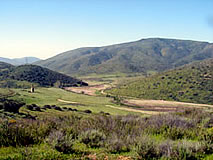San Diego’s scenic backcountry is in play as the County considers new land uses for lands formerly planned for little growth through a voter initiative.

In 1993, San Diego County voters passed the Forest Conservation Initiative which rezoned private lands within the boundaries of the Cleveland National Forest – or “inholdings” – to a low density of 1 unit per 40 acres (or “1:40”). When the County adopted its General Plan Update in 2011, these approximately 70,000 acres were excluded due to the voter-imposed zoning. With the expiration of the measure, the County is now processing an amendment to its General Plan that would conform the former-FCI land to the rest of the General Plan. While the original initiative sponsors contend that the measure has not actually expired, this view has not yet been raised in legal action.
The former FCI lands are among the most remote and distant from infrastructure and services, most fire prone, and most ecologically intact in the County. According to the Guiding Principles of the General Plan, they should largely be retained at 1:40 or changed to 1:80, except in areas dominated by existing smaller parcels and where higher densities are compelled in the interest of consistency.
What might have been a simple exercise in re-planning was complicated when community group and property owner input was used to create a “proposed project” in the Environmental Impact Report for the FCI amendment. The result would be conversions to inappropriate estate residential uses as well as the creation of a new “village” in the town of Alpine beyond existing water and sewer boundaries. However, an environmentally superior alternative (based upon input from EHL and the Cleveland National Forest) was also included. In its comments, EHL pointed out the California Environmental Quality Act mandates the environmentally superior option when, as in this case, it meets all project objectives.
EHL will continue to monitor and participate in this important land use process with the goal of protecting backcountry natural resources and reducing far flung development in high fire risk locations.


